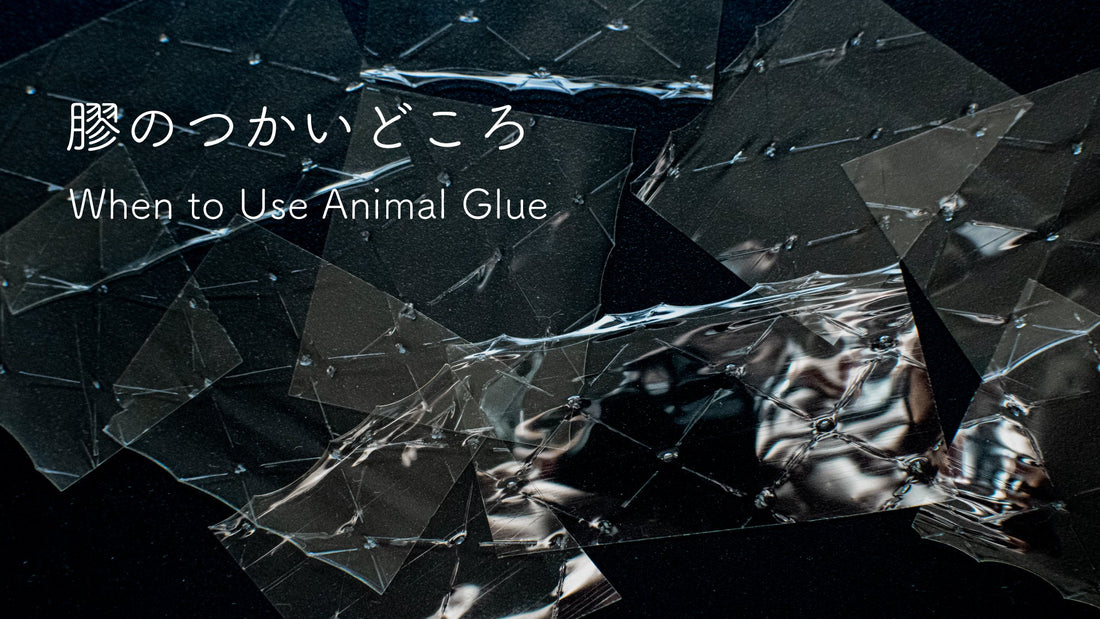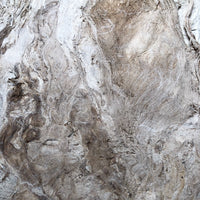For artists who use Washi (Japanese paper) or silk for their paintings, applying Dosa (sizing liquid) is one of the most important processes for preventing blotting, which also affects the finish of the work and its preservation.
Animal glue is the main ingredient of Dosa solution, which also has been used as a binder and adhesive since ancient times and is a familiar material in many fields, including art and manufacturing.
Animal glue is produced by boiling animal bones and skins; its color is translucent or dark tone such as brown, dark brown, or candy brown and it often comes in the form of sticks, plates, or granules, although it’s difficult to tell what kind of characteristics they have simply by their appearances.
When using glue as a painting material, the selection criteria differ depending on the usages, such as binder for paints, adhesion for metal leaves, Dosa sizing, etc. At PIGMENT TOKYO, we have a variety of animal glues made from cows, deer, fish, and so on, and each has a specific purpose according to its characteristics.
Among them, I would like to introduce an animal glue that is the best for making a Dosa solution.
As the picture shows, this glue comes in transparent and thin sheets.
Although the main benefit of a dosa solution made with this highly transparent light-colored animal glue is that the color does not affect the substrates, paints, or metal leaves, the absolute advantage of using this animal glue is its physical property value.
The physical property values that PIGMENT indicates for animal glue are viscosity (Pa・s), jelly strength (JS/g), and pH (ph/hydrogen ion concentration). Among these, having high jelly strength is the most significant feature.
When I compared it with other animal glues available in our store, they are generally classed in the JS 100-500g, however, this pig glue is about JS 600g. (*This data is as of December 6, 2022. Physical properties may vary depending on the stock period.)
Since the main component of animal glue is gelatine, it works well with water and has the characteristics of hygroscopicity that cause the change in the form of the animal glue according to the concentration or/and temperature of the solution.
When animal glue is warm, it becomes a liquid; and when it is cooled, it turns into a gel. Because of its reversibility, the form changes back and forth between the two states depending on the temperature levels.
“JS (Jelly strength)” means the stiffness of the glue when it is in gel form and a higher number represents a higher strength and stiffer jelly.
Then, why is the jelly strength so important for the Dosa and how does it affect the solution?
A typical dosa solution is a mixture of animal glue, alum, and water.
The glue creates a film on the substrates and the alum strengthens the film. The amount (concentration) of alum can control the result of sizing which also means water repellency.
However, when sizing power is increased in this way, acidic alum can deteriorate or discolor the substrate due to oxidation.
On the other hand, the animal glue with high jelly strength does not require alum to form a film and is effective for sizing on its own, therefore, it is recommended to use as Dosa.
Pig glue is especially suitable for sizing artworks that need long-term preservation or does not want the base color to be tarnished in terms of affecting the color of the painting.
Besides the sizing purpose, this animal glue can be used as an adhesive for gold powder, pearl pigments, metal leaves, and so on by diluting it with water.
However, in terms of the high jelly strength, there is a risk of cracking the painting surface (paint) when it is used as a binder for mineral pigments.
Therefore, as painting mediums, other animal glues with lower jelly strength are more recommended.
【Recommended Percentages of Animal Glue Solution 】
Dosa solution works differently depending on temperature and humidity. When applying on Washi paper, it also depends on the raw materials and the weight of the paper. Therefore, kindly refer to the following percentage as a guide and adjust them after trial and error according to your environment and your own preference.
Dosa solution for Washi paper : 3-4%
Dosa solution for silk : 1.5-2%
Medium for gold powder (Kindei) and pearl pigment : 1.5-3%
Adhesive for metal leaf application : 1.5-3% + 1% Alginate Liquid
How to Use Dosa Solution
The following is an instruction on how to make a basic Dosa solution from Pig Skin Glue (Suitable for Dosa/Sizing).
① Measure and put the animal glue and water in a container
Different animal glues come in different sizes and patterns, in the case of "Pig Skin Glue (Suitable for Dosa/Sizing)", it is thin and can be easily cut by hand or with scissors. Then, put the preferred amount of glue and water into a container.
Any kind of container made of stainless steel bowl or glass is fine, as long as it is clean and easy to stir.

② Letting the animal glue rest in the water
We use soft water in our store but tap water is also fine.
However, since animal glue is very perishable, remember to cover the container with a lid and place it in a cool, dark place such as a refrigerator to allow it to absorb water.
Depending on the amount of the animal glue, it may take 1-2 hours for a small amount or several hours at most for the animal glue to fully absorb the water.

③ Diluting it with water
Dilute the animal glue with water by stirring it with a stick.
While diluting it, put the container in boiling water.
The stirring stick should be made of stainless steel or glass to avoid contamination by impurities and for preservation.
④ Adding Preservative・Fungicide (For long-term storage)
For long-term storage, you may add a few drops of preservatives and stir.
Especially when glue solution is used for more than 2 days or when it is used after being out of the refrigerator all day, adding a preservative will prevent spoilage and mold.
Only a small amount, 0.1% of preservative is required, therefore, it will cause no color change or other effects to the substrate.
⑤Ready to use
For long-term storage, keep the solution in a container with a lid that has been boiled or sterilized.
Even if it contains a preservative, glue solution is very perishable, so be sure to store it in the refrigerator and use it within about one year.
If the Dosa solution turns back into gel after storing it in the fridge, warm the entire container in hot water to melt it again.
These are the sample tests with and without applying Dosa.
【Art Materials Used】
Sumi Ink : Daiwagaboku Akanegumo
Substrate : Kozogami (mulberry paper) 10 momme
Dosa Solution Concentration : 3%
Dosa Application : Once on the surface

【Art Materials Used】
Sumi Ink : Daiwagaboku Akanegumo
Substrate : Kumohadamashi
Dosa Solution Concentration : 3%
Dosa Application : Once on the surface
As you can tell from the picture, although both the Kozogami 10 momme and Kumohadamashi are applied with Dosa solution once, some ink bleeding occurred in parts where it appears to have not been covered well. Thus, the same Dosa solution works differently on different types of Washi paper.
Adjusting the Dosa solution and its application can affect the result of the drawing and coloring too.
Especially with thick Washi, applying only to the surface may not work perfectly because the solution is not enough for spreading out on the paper.
In this case, apply the Dosa solution a couple more times or paint it on the front and back sides of the paper, depending on the artwork and substrates.
Furthermore, when and where to use pig skin glue is not limited to ink bleeding prevention on substrates such as Washi and silk but also as an adhesive or varnish of metal leaf. For metal leaf size, animal glue solution alone will dry out too quickly, so adding alginate liquid will slow the drying process. Alginate liquid is a thickening agent extracted from seaweed called Funori.
By doing so, you can dilute the animal glue solution to 1.5-3% and then mix it with 1% of the alginate liquid.
I hope this article will open the door for you to take advantage of the unique characteristics of animal glue to expand your artistic expression and techniques.






